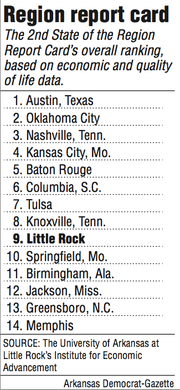LR ranks 9th in area on economy, living
Thursday, September 4, 2014
The Little Rock metropolitan area ranked ninth among 14 cities in a 10-state region in an economic and quality of life study completed by the University of Arkansas at Little Rock.
Austin, Texas, ranked first in the second annual State of the Region Report Card, finishing in the top four in all five major categories: economic performance; economic structure; entrepreneurial and innovative environment; knowledge-based indicators and quality of life.
The study focused on how the metropolitan areas performed since the end of the recession in June 2009.
Little Rock's economy is stable, like a sailboat in a cove, Gregory Hamilton, a senior research economist at UALR's Institute for Economic Advancement and the author of the report, said Wednesday.
"The water is pleasant, the winds are light, it's very stable and things don't change a lot," Hamilton said. "That's Little Rock."
About half of Little Rock's economy is made up of the government, health care and retail sectors, Hamilton said.
"Government and health care are stable sectors," Hamilton said. "And if the economy is stable, retail is stable, too. So when you compare Little Rock against other, more dynamic cities, its performance doesn't look as good."
Little Rock's highest finish was fifth in entrepreneurial and innovative environment indicators. It was seventh in knowledge-based indicators and quality of life indicators and 12th in economic performance indicators and economic structure indicators.
Little Rock's strengths bode well for its future as an innovation-driven economy, Hamilton said in the report.
The report is "a good snapshot of a number of dimensions of the Little Rock economy compared to some similar cities and those that Little Rock is often in competition with when we're trying to get businesses to come to the area," said Michael Pakko, chief economist at UALR's Institute for Economic Advancement.
"If you don't take a snapshot and see where you're doing well and where you're not doing so well, obviously you can't accentuate the positive and work on your weaknesses," said Jay Chesshir, president of the Little Rock Regional Chamber of Commerce.
The one area where Little Rock could focus over the next five years to help it improve would be educational attainment, Pakko said. Little Rock ranked third in the percentage of the population with a high school degree, but fell to eighth for those with a bachelor's degree, the report said.
"That's the kind of issue that community leaders can have some effect on," Pakko said.
Austin was first in the entrepreneurial and knowledge-based categories. Oklahoma City, which finished second overall, was first in economic performance indicators and economic structure indicators. Columbia, S.C., which was sixth overall, finished first in quality of life.
Besides Little Rock, the other cities included in the rankings were Austin; Baton Rouge ; Birmingham, Ala.; Columbia, S.C.; Greensboro, N.C.; Jackson, Miss.; Kansas City, Mo.; Knoxville, Tenn.; Memphis; Nashville, Tenn.; Oklahoma City; Springfield, Mo.; and Tulsa.
Austin, Oklahoma City, Kansas City and Nashville were included in the report because they have traits that Little Rock leaders hope Little Rock can attain. The other cities were considered to be more comparable to Little Rock.
In the first State of the Region Report Card last year, Little Rock was 10th out of 11 cities. UALR added three cities to this year's study, Hamilton said.
Economic performance in the report was based on gross domestic product, employment and income. Economic structure considered the industrial mix of businesses, business competitiveness and business specialization. The entrepreneurial and innovation environment category was a measure of technical activity, an innovation index and business churn, defined as the turnover of businesses. The knowledge-based indicators included educational attainment, the quality of the labor force and workers with science, technology, engineering and math skills. The quality of life category looked at culture and recreation, housing affordability, crime rate and transportation.
Business on 09/04/2014
